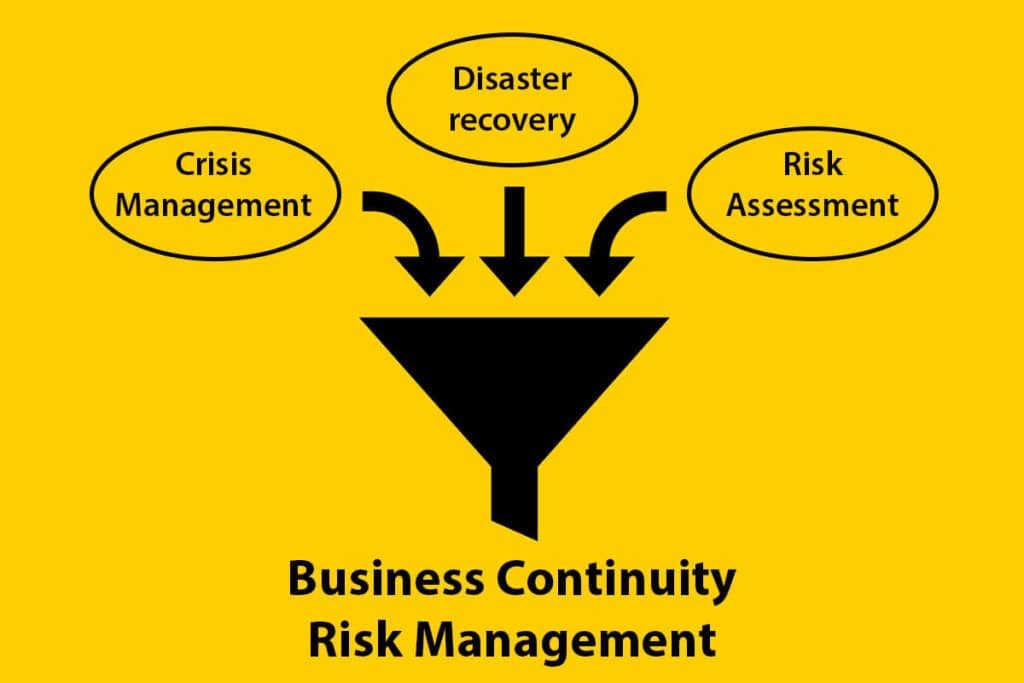Key Highlights of this Blog
- Provide an understanding of business continuity risks and the need for a strategic framework to address them.
- The definition and importance of business continuity and risk management in safeguarding operations.
- Integrating enterprise risk management (ERM) and business continuity planning (BCP) for improved organizational resilience.
- The key elements of business continuity risk management, which include risk assessment, crisis management, and disaster recovery planning.
- The tools and strategies for effective business continuity risk management, such as automated risk assessment and real-time data.
- The importance of cultivating a culture of continuity and embracing a proactive approach to risk management.
Table of Contents
Toggle
Introduction
Businesses face many risks that can disrupt operations from diverse threats like natural disasters and cyber-attacks. Planning to address these risks helps ensure business survival, making business continuity and risk management essential for protecting operations and maintaining resilience.
Business continuity management (BCM) identifies threats and their impacts on operations, ensuring effective responses to safeguard critical interests can be implemented.
Risk management assesses threats to capital and earnings and enables the organization to implement strategies that manage them effectively.
Both disciplines collaborate to address risks for long-term organizational sustainability proactively.

Understanding Business Continuity and Risk Management
To implement business continuity and risk management effectively, you need a clear understanding of the concepts involved.
Business continuity ensures critical functions are maintained during and after a disaster. It includes identifying risks and developing strategies for service continuity.
Risk management focuses on identifying, assessing, and controlling threats to capital and earnings. Business impact analysis (BIA) is a key tool that quantifies disruption impacts, guiding recovery efforts. Resilience involves building the capacity to withstand disruptions proactively.
What is Business Continuity Management (BCM)?
Business Continuity Management (BCM) identifies threats to an organization and their impacts on operations. It builds resilience for an effective response, safeguarding stakeholders, and reputation. Components include business impact analysis (BIA) to quantify disruptions and develop recovery strategies. Plan development includes documenting procedures, resources, and testing for effective crisis response.
Exploring the Scope of Risk Management in BCM
Risk management is essential in business continuity management (BCM) to identify, assess, and control threats to an organization’s capital and earnings. It helps pinpoint risks that could disrupt operations. These can be internal (like system failures or human error) or external (natural disasters or cyberattacks).
Other risks include supply chain disruptions, legal issues, market fluctuations, and geopolitical events. Through a thorough risk assessment, organizations prioritize potential risks and create a robust business continuity plan for crisis management.

Integration of Enterprise Risk Management and Business Continuity Planning
Integrating enterprise risk management (ERM) and business continuity planning (BCP) enhances an organization’s ability to manage risks and ensure business continuity.
- ERM identifies, assesses, and manages risks that could affect organizational objectives.
- BCP focuses on maintaining critical functions during disruptions.
This integration enables a proactive approach to risk management, providing a comprehensive understanding of risks and their impact on operations. This allows effective mitigation and continuity strategies.

How ERM Complements BCP for Organizational Resilience and Preparedness
Enterprise risk management (ERM) and business continuity planning (BCP) work together to enhance organizational resilience and preparedness.
- ERM focuses on identifying, assessing, and managing risks that could impact an organization’s ability to achieve its objectives. Once documented, these risks can be prioritized and addressed through BCP.
- BCP explicitly addresses the continuity of critical business functions. The practice examines the risks identified and develops plans to address them.
By integrating ERM and BCP, organizations can take a proactive approach to risk management and ensure the continuity of critical functions during and after a disaster or disruption.
ERM provides a framework for identifying and assessing potential risks, while BCP focuses on developing strategies and plans to ensure the continuity of critical functions within a specific time frame.
Integrating these approaches ensures a holistic program is in place to address and respond to existing and new threats continually.
The Strategic Importance of Integrating ERM with BCP
Integrating enterprise risk management (ERM) with business continuity planning (BCP) is strategically important for organizations aiming to enhance their resilience and ensure the continuity of critical business functions.
It enables organizations to take a proactive approach to risk management and develop comprehensive strategies to mitigate potential risks. This alignment ensures that risk management measures protect the organization and align with its long-term goals and direction. It also enables adjustments to the planning to occur as business needs change.
The integration of ERM and BCP enables organizations to identify potential risks, assess their impact, and develop strategies to ensure the continuity of critical functions. This alignment ensures that risk management efforts align with the organization’s strategic objectives, enhancing the overall effectiveness of risk management and business continuity planning.

Key Elements of Business Continuity Risk Management
Business continuity risk management (BCRM) encompasses several essential elements for organizations aiming to protect their operations and maintain resilience.
Risk Assessment
BCRM’s primary focus is risk assessment. This includes identifying threats and assessing their potential impact on business operations. This assessment helps organizations prioritize risks and develop strategies to mitigate them.
Disaster Recovery to Minimize Downtime
Disaster recovery is another key element, focusing on the steps needed to quickly and efficiently recover critical business functions after an incident that causes downtime.
This includes developing clear communication strategies, identifying key personnel and resources, and conducting regular testing and drills to ensure the plan’s effectiveness.
Crisis Management
Crisis management is also important in BCRM, as it involves using a prepared response when managing adverse events. This includes developing strategies to handle various crisis scenarios and ensuring the organization is equipped to respond effectively.
Combining these three elements into a robust and holistic approach is critical to success. Thus, it’s important to examine each more deeply to understand its contribution to the organization’s overarching business continuity risk management plan.
Risk Assessment in BCRM: Identifying Potential Threats
Risk assessment is critical to business continuity risk management (BCRM). It helps identify threats that could disrupt or halt an organization’s operations.
Risk assessment steps include:
- Gather business stakeholders like department heads. They understand the potential impact of an interruption in their lines of business.
- Identify the organization’s risks in its internal and external environment. This includes potential threats such as natural disasters, cyber-attacks, supply chain disruptions, or operational oversights.
- Determine each risk’s potential impact on the organization’s objectives. This analysis helps organizations prioritize risks and develop strategies to manage and mitigate them.
These steps enable organizations to develop a business continuity and risk plan that aligns with their goals and objectives and continues to evolve as business needs grow and change.

Crisis Management: Preparing for and Managing Adverse Events and Downtime
Crisis management is a key element of business continuity risk management (BCRM). It involves preparing for and managing adverse events that could disrupt an organization’s operations. Effective crisis management requires careful planning and preparation to ensure a swift and effective response.
Aspects of crisis management include:
- Developing strategies to handle various crisis scenarios and planning the routine execution of these strategies.
- Ensuring the organization has the necessary resources and personnel to respond effectively
- Establishing clear communication strategies to keep stakeholders informed
- Conducting regular training and drills to ensure preparedness

Disaster Recovery and Incident Response: Ensuring Operational Continuity
Disaster recovery and incident response play a crucial role in ensuring the continuity of an organization’s operations.
Disaster recovery focuses on the steps needed to restore critical business functions quickly and efficiently after a disaster or incident. This includes restoring IT systems, data recovery, and implementing backup plans to ensure operational continuity.
On the other hand, incident response involves the immediate response to an incident or crisis. This includes activating response plans, coordinating resources, and communicating with stakeholders to mitigate the impact of the incident. Incident response is a part of daily operations and may need to be performed in the event of routine equipment failures.
Both disaster recovery and incident response require organizations to have resiliency and data backups before an adverse event occurs. This requires advanced planning based on the risk assessment work performed as part of BCRM efforts.

Tools and Strategies for Effective BCRM
To implement effective business continuity risk management (BCRM), organizations can leverage various tools and strategies to enhance their resilience and ensure the continuity of their operations.
- Automated risk assessment software: These tools help organizations identify their risks and vulnerabilities and prioritize how they should be addressed. They can also help with scenario planning in the event of an adverse event.
- Real-time data analysis tools: These products help organizations monitor and analyze data in real time. This enables organizations to identify potential threats or disruptions and take immediate action to minimize their impact on operations.
- Cloud and other virtual technology: The use of cloud offerings like Amazon Web Services, Google hosting, Azure Cloud, and others enables organizations to recover from severe data center or hardware interruptions. They also provide backup data and resiliency.

Leveraging Automated Risk Assessment for Proactive Management
Automated risk assessment is a valuable tool in business continuity risk management (BCRM) as it allows organizations to identify and assess potential risks proactively. Organizations can enhance their proactive management efforts by leveraging automated risk assessment tools and effectively mitigating potential risks.
Automated risk assessment helps organizations perform the following tasks:
- Identify and document vulnerabilities and potential threats.
- Prioritize risks based on their potential impact on the business.
- Develop strategies to manage and mitigate them proactively.
By automating the risk assessment process, organizations can save time and resources while ensuring a comprehensive and consistent approach to risk management.

The Role of Real-Time Data Analysis in Risk Mitigation
Real-time data analysis supports business continuity risk management (BCRM) as it enables organizations to monitor and analyze data in real time. By leveraging real-time data analysis, organizations can effectively identify potential risks and take immediate action to mitigate them, ensuring the continuity of their operations.
Real-time data analysis allows organizations to monitor key indicators and identify potential risks or disruptions as they occur. This enables organizations to respond quickly and take proactive measures to minimize the impact on their operations.

Scenario Planning: Anticipating and Preparing for Future Events
Business continuity and risk management are vital for organizations to navigate the complex and interconnected world of business. Scenario planning is an essential tool in this process. It involves anticipating and preparing for future risks, including a myriad of risks, by exploring various scenarios and developing a robust contingency plan.
By considering different possibilities, organizations can develop strategies to mitigate the impact of potential disruptions. This proactive approach makes businesses better prepared and equipped to respond effectively to unexpected challenges. Scenario planning helps organizations identify potential risks, evaluate their likelihood and impact, and develop appropriate response strategies.
Conclusion
A strategic Business Continuity and Risk Management approach is imperative for organizational resilience. The integration of Enterprise Risk Management with Business Continuity Planning enhances preparedness for potential threats and ensures operational continuity. Risk assessment, crisis management, and disaster recovery are pivotal in mitigating adverse events.
Leveraging tools like automated risk assessment, real-time data analysis, and scenario planning bolsters proactive risk management.
Aligning BCRM with business objectives minimizes financial losses and reduces operational downtime. By embracing effective BCRM strategies, businesses can navigate uncertainties with confidence and fortify their foundations.




